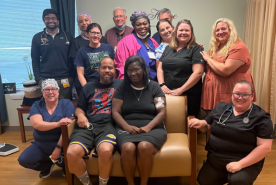What is the buttonhole technique?
The buttonhole technique is a way to "cannulate," which means "to insert dialysis needles." Instead of sharp, pointed needles, dull needles are placed into the exact same holes on your fistula every time you have dialysis. Inserting the needles in the same holes creates a "tunneled track" for the needle. Over time this may be less painful because you do not have to use sharp needles to make new holes in your skin and in your fistula. The track is a tunnel created through the skin and fistula by the formation of scar tissue - just like the hole made in an earlobe for a pierced earring. This technique is a good alternative to rotating sites, which can cause aneurysms (parts of the fistula wall that have become weak and stretched out of place).
Who can use the buttonhole technique?
The buttonhole technique can only be used by patients with an AV fistula, and cannot be used by those with an AV graft. It can be used by patients who self-cannulate (insert their own needles) either at home or in a dialysis center, after approval from their healthcare provider. In fact, because there is little or no pain from the dull needles going through the track, more people are willing to learn how to self-cannulate! Staff trained in the buttonhole technique can also insert your needles if you prefer.
What should I do if I am interested in trying the buttonhole technique?
If you would like to learn more about the buttonhole technique, speak with your healthcare provider or dialysis nurse. Even if they are not using this technique in your center, there are very good resources, as listed below, to help both staff and patients.
What is the best way to take care of my buttonhole sites?
It is important to make sure you perform the buttonhole technique in the right way to reduce problems. Infection is the biggest concern with this technique. But knowing how to care for your buttonhole sites will keep them problem-free for a very long time. Here are some ways to reduce your risks:
Clean skin and buttonhole sites very well - Because buttonhole sites are permanent exit sites, bacteria (germs) will collect around them. Staph (short for Staphylococcus) is a type of bacteria commonly found on the skin that is generally harmless, but can cause infection if sterile technique is not used when caring for your access. In addition, patients on dialysis have more staph germs on their skin than the general population. Therefore, extra cleaning is needed and the following are steps to take:
- Wash your access before sitting down to cannulate
- Before removing scabs, disinfect sites
- Remove scabs completely
- Disinfect one more time
- Let skin dry
- Cannulate
Wear a mask when inserting and removing needles - Staph is also found in the nose and you can breathe bacteria onto your buttonhole sites. Buttonhole infections are the same as catheter infections, so protect yourself with a mask when placing and taking out your needles. In order to prevent the spread of germs, you should also wear gloves.
Insert needles at the correct angle - Inserting your needles at the exact same angle and depth is very important for making perfect buttonhole sites. Not hitting the same site can cause the following:
- Aneurysms
- Extra tunnels for bacteria to hide in
- Not being able to change from sharp to dull needles
Hold your needle sites after you take out your needles - Take out needles one at a time. After taking out one needle, hold that site by using two fingers. Every needle makes two holes: one in the surface of the skin, and one in the blood vessel (fistula) wall. Two fingers will cover both holes, making a solid clot. This will prevent blood from filling your tunnel and causing a large blood clot; smaller scabs that are easier to remove will form instead.
Where can I find more information?
National Kidney Foundation
Hemodialysis Access
ESRD Network Coordinating Center- Fistula First Breakthrough Initiative
Phone: 516.209.5332
Email: FFBI@ncc.esrd.net
Web: www.fistulafirst.org
National Kidney and Urologic Diseases Information Clearinghouse
Phone: 1.800.891.5390
Email: nkudic@info.niddk.nih.gov
Web: http://www.kidney.niddk.nih.gov








